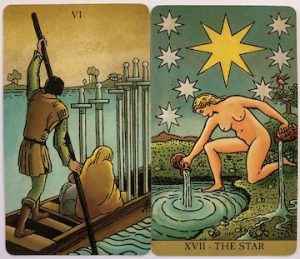Practical Techniques for Better Readings
Marcus Katz and Tali Goodwin

Something that many people struggle with is not learning what the individual cards mean but being able to create a message from the cards in a reading that makes sense. A card by itself is easy enough to learn. Put three or more cards on the table and some people have trouble making it flow. Practical Tarot Techniques is filled with very practical skills that will help you become a better reader by helping you interpret and communicate what you interpret clearly. Here’s just one of the many techniques you will find in Practical Tarot Techniques.
There is a skill that is important to learn—that of bridging. Bridging can be defined as visually and/or intuitively connecting the symbols of the cards in a way that makes sense in the context of the reading.
When experienced tarot readers look at cards and symbols, they are able to make “bridges” of interpretation between the symbols. For example, they might tell the querent, “In this card (the Two of Swords) and in this one (Justice), we see a blindfold. The sword held by Justice tells me that the decision in your legal case will be reached soon and will be fair to you, even though you cannot see it at the moment.” For some, this skill of bridging is a natural ability; for others, it can be gained from experience. Either way, it can be taught, and learnt, as a specific skill that will rapidly build your tarot-reading confidence.
Exercise: Bridging
In this example, we will use the Six of Swords and the Star. Here’s what we might say about bridging these two cards:
6 of Swords and the Star

The Six of Swords shows a daytime background, while the Star is visible only at night. It would be great to be on a journey, as in the Six of Swords, with the Star card ahead like a guiding beacon. There is water in both cards, although it is being controlled more in the Star card. I get the general feeling that both cards have something to do with flow.
Now take two cards from your deck. Make a note in your journal or say out loud what you can see that bridges these cards. In other words, what happens in your mind when you see these two images together? Our minds are automatic sense- makers (and sense-breakers) in the processes we call language and learning. Images and symbols are part of that—in fact, you are doing it now to make sense of these weird black squiggle shapes on the page.
You can use comparisons, contrasts, themes, distinct symbols, colour, shape, form, numbers, or anything else that occurs to you. The important thing is not to try and interpret the cards, nor make sense of them individually. This is not what good tarot readers do at all, although it is the way tarot tends to be taught, unfortunately—one card at a time.
Don’t reject any thought that arises, whether it is a statement of fact or an intuitive impression—especially things that don’t appear to make sense. Have fun and let your consciousness flow until you can’t say or write anything more. The goal is to face the cards in a spirit of enquiry, so if you feel as if you are working too hard or having trouble, simply shuffle the deck and choose a couple of different cards.










[…] Via the Llewellyn blog, a look at Practical Tarot Techniques. I am adding it to my TBR list because of my interest in Tarot and cartomancy, but I will note my luck with books by Marcus Katz and Tali Goodwin has been so-so. Still, willing to take one more chance. […]